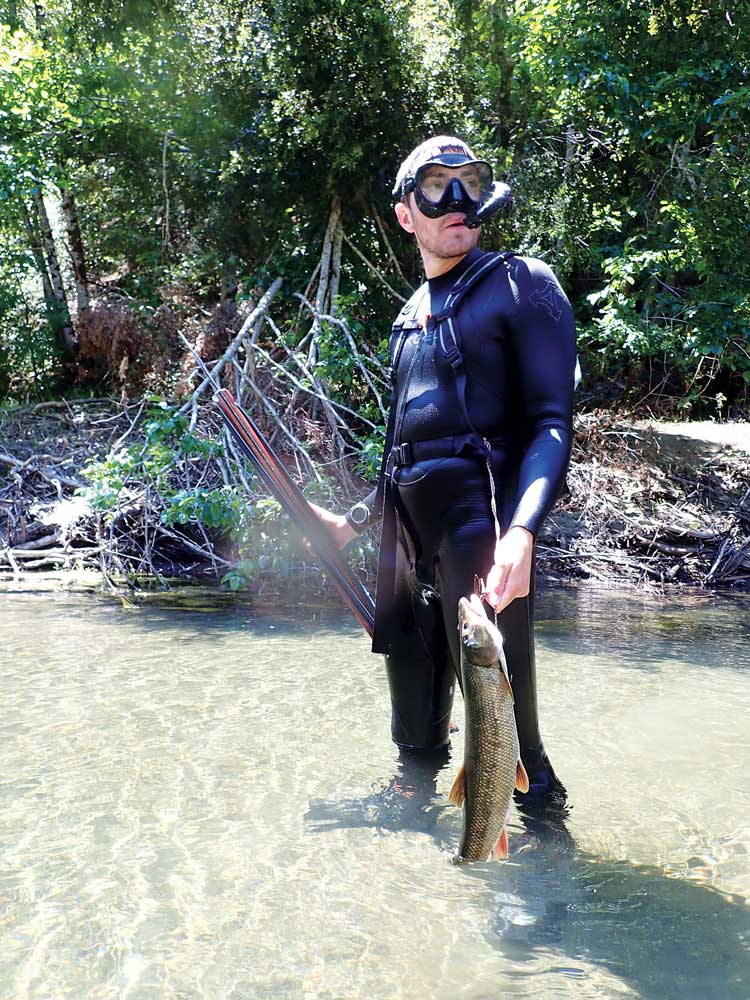Eel River Recovery Project Field Notes
South Fork Eel River 2023 Pikeminnow Survey Provides Encouraging Results

By Pat Higgins, Managing Director, Eel River Recovery Project
The Eel River Recovery Project (ERRP) conducted its eighth annual survey of invasive Sacramento pikeminnow on the South Fork Eel River from Rattlesnake Creek to Standish Hickey State Park on June 28 and 29, and results were surprising. The invasive pikeminnow population was far lower than the previous three years, and native steelhead trout were more abundant than any year since surveys began in 2016. The dive team was led by University of California-Berkeley post-doctoral researchers Phil Georgakakos and Gabe Rossi, who were joined by undergraduate students and fish biologist and ERRP Managing Director Pat Higgins for the two-day, 12-mile survey.

ERRP began the pikeminnow surveys at the recommendation of Dr. Bret Harvey, who did extensive studies of pikeminnow in the Eel River for Redwood Sciences Lab, a research branch of the U.S. Forest Service. He noted that the upper South Fork was a major producer of Chinook and coho salmon and steelhead trout, but that large pikeminnow predation (on salmonids) could be limiting their populations. From 2016 through 2019, the population of pikeminnow greater than four inches in length oscillated between 614 and 1,414, increasing dramatically in 2020 to 6,639 due to favorable conditions afforded by record drought. The population maintained high levels at 4,075 and 3,867 in 2021 and 2022, respectively, but dropped to 1,164 this year.
High flows like those experienced the previous winter showed co-relations with reduced numbers of smaller fish (<8”), but the number of large adults was low. The reason for the decline of larger fish may be related to new cooperative efforts by UCB, CalTrout, the Wiyot Tribe, and the California Department of Fish and Wildlife (CDFW). In addition to setting up a weir on the SF Eel near Piercy to trap adult pikeminnow during seasonal migrations, UCB and the Wiyot can use nets and spears to remove them. During the 2023 survey, eleven large pikeminnow were speared during the two-day dive, and dozens more after UC divers returned to reaches where we had seen concentrations of adults.

Before the dive team hit the water on day one of the survey at Rattlesnake Creek, dimples on the surface indicated active feeding by rainbow trout or steelhead juveniles. Flows were high enough during the 2023 survey that divers could float through many riffles, which is much more fun than rock-hopping during dry years. Moving downstream through riffles and cascades, the team would knock insects off rocks, driving the trout into a feeding frenzy. Amazingly, the UCB team was able to count salmonids as well as pikeminnow, and they found there were 2,375 trout from 2” to 16” in length. Small young of the year fish comprised only 436 of the total, so the vast majority of fish were yearlings or older, with the largest fish likely resident trout.
Winter flows needed for successful steelhead spawning were lacking in 2020 and 2021, and ocean conditions may be changing, resulting in lower adult returns. Luckily steelhead and rainbow trout are the same species and capable of adopting a sea-going or anadromous life history or remaining in freshwater as resident trout. It is possible that residents are helping maintain a high population level. Also, flood flows in tributaries, like Tenmile Creek near Laytonville, in the previous winter appear to have caused low survival of eggs and fry, but they may also have washed rearing steelhead juveniles and resident trout downstream and into the main South Fork.

Large areas of intact watershed upstream of the dive reach in the UC Angelo Reserve and the Cahto Peak and Elkhorn Wilderness Areas produce copious amounts of cold water and low sediment levels, which make the South Fork Eel River ecosystem in this reach highly productive even during droughts.
While it is too soon to tell whether reduction of large adult pikeminnow is responsible for the upswing in trout standing crops, this hypothesis can be tested by continuing to collect trend data in the index reach. To learn more or volunteer for the 2024 survey, call (707)223-7200 or go to eelriverrecovery.org.

